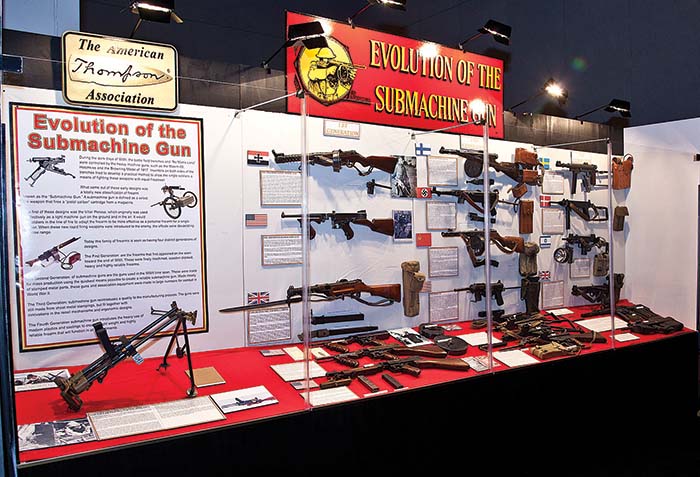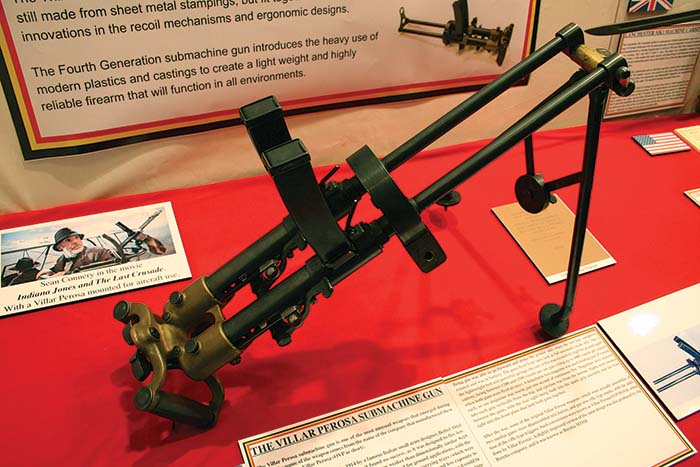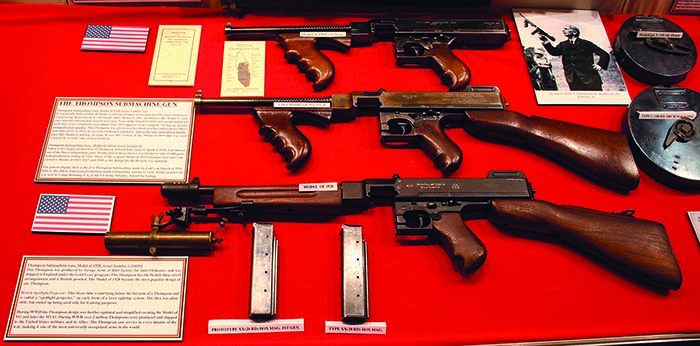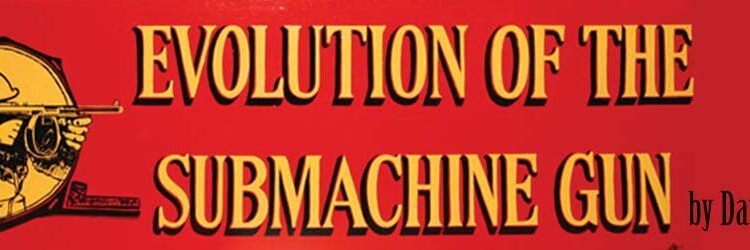By David Albert
Evolution of the Submachine Gun
Awarded “Best Display” by NRA at the
Annual Meetings and Exhibits in St. Louis, 2012
Every spring, the National Rifle Association holds its Annual Meetings and Exhibits in a different American city. Firearm related vendors present their wares or services for 3 days of exciting 2nd Amendment celebration. This year, St. Louis hosted the event during the weekend of April 13-15, and a record 73,740 NRA members attended. NRA affiliated collector organizations are encouraged to participate, and the NRA sets aside one row of exhibit space for club displays on various firearm subjects. In 1960, a perpetual silver cup trophy was introduced for the best display, which is now a coveted award inspiring tremendous competition.

The American Thompson Association (TATA) won the best display trophy this year, for an unprecedented third year in a row. In fact, TATA has won the award 4 out of the last 6 years at NRA. This fact is well known among the competing clubs, and there is one individual who deserves most of the credit for the success trend, and his name is Tracie Hill. Mr. Hill is the author of The Ultimate Thompson Book, published in 2009 by Collector Grade Publications. He is supported by a cadre of dedicated TATA members who attend the events at their own expense, lend firearms to the display, help to transport and erect the display, provide tours, answer questions, and subsequently dismantle the display at the conclusion of the event. The amount of work required to present a top notch display is considerable, and attention to detail is closely calculated. TATA’s displays are crowd pleasers, and this year’s display theme was “Evolution of the Submachine Gun.”
The highlight of the display was an example of the first submachine gun ever produced, the Italian Villar Perosa in 9mm Glisenti caliber. Invented in 1914, and originally fielded as an aircraft machine gun that happened to be chambered for a pistol cartridge, the weapon saw little success when used during WWI. Aircraft use of the weapon proved its ineffectiveness, and several other mounting schemes were attempted for the side by side double submachine gun. One method involved mounting the weapon to a soldier’s chest, but the arrangement was cumbersome, and probably attracted immediate return fire. The Villar Perosa, and several other submachine guns, represented the first of 4 different generations of submachine guns displayed at the show.

First generation submachine guns are characterized by intricate design and high quality machining, and finishes similar to fine firearms of the era. The Bergmann MP 18 was another example on display, including some rare accessories, such as the folding mud cover for the muzzle, and a snail drum magazine end cover. The MP 18 was known as a machine pistol at the time of its invention and use during WWI. The term “submachine gun” was not coined until the Thompson was invented, which missed WWI by a few months. Two Model of 1919 Thompson submachine guns were featured, as well as a Model of 1921 Thompson, serial number 41; the first Colt Thompson manufactured out of 15,000 produced between 1921-22. Another Thompson displayed was a Model of 1928A1, produced by Savage for Lend-Lease to Britain, which featured the rare spotlight illuminator device, which attached to the horizontal foregrip, sort of like an early Picatinny rail flashlight mount.
Second generation submachine guns introduced designs for greater ease of mass manufacturing, prior to, and during WWII. Examples presented were a Suomi M31, with its unique, high capacity magazine designs, such as the coffin magazine, and the Suomi drum. During the Finnish-Russian Winter War of 1939-40, the Russians learned of the effectiveness of the M31 through significant casualties suffered from it, and mimicked the design in their own later PPSh 41 submachine gun, of which more than 6 million were produced. An example PPSh 41 was displayed, along with what many attendees recognized as the main German submachine gun of WWII, the MP 40. Four different types of Sten submachine guns were featured, including a Mk 1, Mk II, Mk III, and Mk V. The Sten set the record for the most cost effective submachine gun design, and its de-centralized manufacturing by scores of individual parts makers around Britain represented a strategic choice in order to reduce potential risks of total loss of its production capacity as the Germans continued to bomb Britain each night. Sten production eventually totaled between 3 and 4 million units. A U.S. M3 “Greasegun” rounded out the second generation examples, and several stories came forth as veterans who used the weapon during its service history into the 1990s could attest to its slower rate of fire, and .45 caliber effectiveness.

Following WWII, a return to higher quality manufacturing techniques occurred, and design became focused on better ergonomics. The first example displayed was a very nice Swedish Carl Gustaf M45 submachine gun, followed by the unique Danish Madsen M50. Several individuals mentioned seeing the M50 in 1960s and 70’s television shows, and most had never seen one in person. Many attendees recognized the Israeli designed Uzi submachine gun on display, which was unique in that it was of FN manufacture, and one of two examples specifically imported for consideration of adoption by the CIA. The Sterling submachine gun displayed showed how the earlier Sten became enhanced with a better magazine, and friendlier ergonomics and folding stock design.
The fourth generation was represented by the Heckler & Koch MP5 submachine gun and its use of plastic furniture and closed bolt design for much greater accuracy. It is still the standard submachine gun of most police departments, and sees continued use by many other agencies and militaries around the world. The display concluded with suppositions about future direction of the submachine gun, including incorporation of .223 caliber designs into bullpup, submachine gun sized configurations such as the FN F2000, as well as the move toward designs such as the FN P90, which uses a hybrid pistol and rifle cartridge in a personal defense weapon configuration with greater range provided by the versatile 5.7mm x 28mm caliber.

Besides the satisfaction of presenting a great display that NRA members often stand 4-deep to view, participating in the manning of the display always brings other benefits, such as the stories that are exchanged, and contacts made with others sharing similar interests. Because of a contact at the St. Louis display this year, what appears to be a transferable M1 Thompson in the possession of an Illinois police department is being fostered by a retired police officer member of TATA through the verification process with ATF for eventual sale by the department to the public, as a benefit to their constrained budget. Previously, when TATA displayed at NRA in St. Louis in 2007, a whole chapter was added to Thompson history as a key family contact came forth when they saw the incredible 40-foot wide display of Thompsons featured at that show. TATA won the “Best Display” award in 2008 in Louisville for their display theme, “Calvin Goddard: CSI – The St. Valentine’s Day Massacre,” and again in 2010 in Charlotte for “Internal Views of the Tommy Gun,” in 2011 in Pittsburgh for “The Machine Gun Designs of John Browning,” and now in St. Louis for “Evolution of the Submachine Gun.” A special thanks goes out to Allan Cors, Ken Keilholz, and Bob Landies for their support and loan of arms and accessories in the award winning St. Louis display. Next year, Houston will host the NRA, and current plans by TATA are to skip the show due to the logistical distance. Stay tuned for another great display by TATA in Indianapolis in 2014.
| This article first appeared in Small Arms Review V16N4 (December 2012) |












